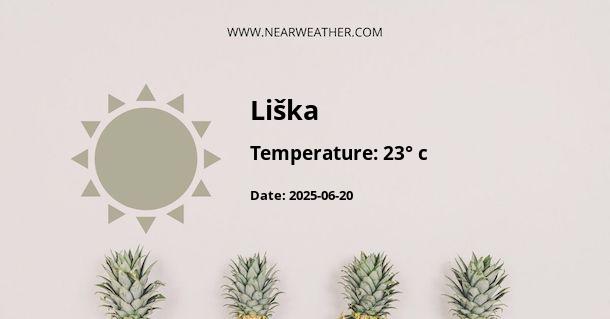Understanding the Climate and Weather Patterns in Liška, Croatia
The charming area of Liška is nestled in Croatia, a country known for its diverse climate zones, ranging from the continental in the interior, a mountainous climate in the Lika and Gorski Kotar regions, to Mediterranean along the Adriatic coast. Liška in particular, is situated within the mountainous regions, where the climate can be quite distinct from other parts of Croatia.
In this comprehensive guide, we will delve into the specific aspects of Liška's climate, exploring temperature ranges, precipitation levels, seasonal changes, and extreme weather events, providing valuable insights into the area's weather year-round.
Seasonal Climate Overview of Liška
Winter in Liška
Winter months in Liška can be harsh, with cold temperatures often dipping below freezing. The area witnesses a significant amount of snowfall, making it a winter wonderland for visitors and residents alike, but also posing challenges such as snow accumulation and road accessibility.
- Average Temperature Range:
- -5°C to 3°C (23°F to 37.4°F)
- Typical Snowfall:
- High, frequent snowfall from November to March
- Weather Events:
- Heavy snowfall, icy conditions, occasional freezing rain
Spring in Liška
Spring brings a gradual increase in temperatures and a thawing landscape. This is a transitional season where weather patterns can vary significantly, swinging from a late frost to warmer, sunnier days as it progresses.
- March: Cold with lingering snow
- April: Warmer with rain showers and possible late frosts
- May: Noticeable warming trends, more regular sunshine
Summer in Liška
Summer is relatively cool due to Liška's elevation and topographical influences. It is an ideal season for outdoor activities, as the region does not experience the heat intensity found in the lower Adriatic areas.
- Average Temperature Range:
- 15°C to 25°C (59°F to 77°F)
- Rainfall:
- Moderate, with occasional thunderstorms and rain showers, especially in the afternoon and evening
- Weather Events:
- Scattered thunderstorms, rarely extreme weather
Autumn in Liška
Autumn witnesses a gradual cooldown, with the weather remaining comfortable through September, followed by a crisper atmosphere and the first frosts typically arriving by November.
- September: Mild with decreasing rain
- October: Cooler with increasing chances of frost
- November: Beginning of the colder conditions, preparation for winter
Average Year-Round Temperatures and Precipitation
In order to provide a clear understanding of what to expect weather-wise in Liška throughout the year, the table below breaks down average temperatures and precipitation levels:
| Month | Average High (°C/°F) | Average Low (°C/°F) | Precipitation (mm/inches) |
|---|---|---|---|
| January | -1/30 | -6/21 | 75/3 |
| February | 1/34 | -4/25 | 70/2.8 |
| March | 6/43 | 0/32 | 80/3.1 |
| April | 11/52 | 4/39 | 85/3.3 |
| May | 16/61 | 9/48 | 100/3.9 |
| June | 20/68 | 12/54 | 120/4.7 |
| July | 22/72 | 14/57 | 110/4.3 |
| August | 22/72 | 14/57 | 120/4.7 |
| September | 18/64 | 11/52 | 150/5.9 |
| October | 13/55 | 7/45 | 180/7.1 |
| November | 7/45 | 2/36 | 170/6.7 |
| December | 2/36 | -3/27 | 140/5.5 |
Prevalent Weather Phenomena
The mountainous terrain around Liška plays a significant role in driving localized weather phenomena. Understanding these patterns is essential for planning activities, crop cultivation, and managing weather-related risks in the region.
Bora Winds
Bora winds are a common occurrence in the area and can have a significant impact on local weather conditions, particularly during winter and spring. They are strong, cold, northeasterly winds that descend from the mountains to the coast, sometimes reaching hurricane-force speeds causing abrupt temperature drops and turbulent seas.
Fogs and Inversions
Due to its topography, Liška often experiences fogs and thermal inversions, especially during the colder months. These meteorological conditions arise when a layer of warm air traps cold air at the surface, leading to the build-up of moisture and reduced visibility.
Thunderstorms
In the summer, Liška's climate features convective thunderstorms, which tend to occur during the afternoon and evening hours. These storms can be quick to form but also dissipate relatively fast, though they are capable of producing heavy rainfall and lightning.
Climate Adaptations and Considerations
When operating within the climate of Liška, various adaptations and considerations are necessary. For instance:
- Architecture: Buildings are often designed with the heavy snow and strong winds in mind, utilizing steeper roof slopes to prevent snow accumulation and enhanced insulation to combat the cold.
- Agriculture: Farming activities must accommodate the shorter growing season and the potential for late or early frosts.
- Tourism: Winter sports are popular given the significant snowfall, while summer activities capitalize on the mild temperatures and beautiful mountain landscapes.
Conclusion
Liška’s climate reflects the contrast and diversity that define Croatia’s weather patterns. From the cold, snowy winters to the pleasant, mild summers, the region offers a unique climate profile that shapes the daily life and activities in the area. Understanding these weather variations is key for anyone looking to visit, live in, or study the meteorological nuances of this picturesque Croatian location.
A - Liška's Latitude is 44.576672 & Longitude is 14.376110.
A - Weather in Liška is 11° today.
A - Climate Conditions in Liška shows scattered clouds today.
A - Humidity in Liška is 62% today.
A - Wind speed in Liška is 11.45 km/h, flowing at 13° wind direction. today.
